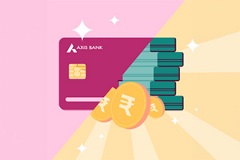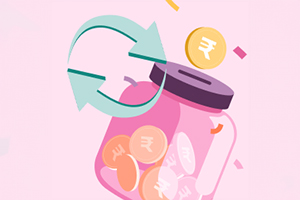With the advent of digital payments, Debit Cards and Credit Cards have gained much prominence. However, have you ever wondered how exactly a Debit Card works? When you enter the Debit Card details online, you must enter your Debit Card number, expiry period, and CVV. You must have thought, What is CVV in Debit Card? Let’s obtain a better understanding of what is CVV security code in Debit Card and its importance.
What is the CVV code in Debit Card?
The CVV's full form is Card Verification Value. It is a 3-digit code printed behind the debit and Credit Cards. It is also the card verification code or the card security code. It acts as an additional security layer to ensure the protection of online transactions, especially when you swipe the Debit Cards on the POS machines. CVV also verifies that the card is available when initiating online transactions.
Ensure you do not disclose your card’s CVV code to anyone. Merchandise portals are not allowed to save the CVV number of anyone’s cards. Saving CVV is against the Per Payment Card Industry Data Security Standards (PCIDSS). Therefore, while merchants may end up saving your card details, they cannot save CVV, thus preventing misuse of your cards. The card issuers generate the CVV codes on your debit and Credit Cards. If you are thinking about what is ATM card CVV number is, then the Debit Card itself is your ATM card, and therefore, the CVV number is the same.
Where to find the CVV code in a Debit Card?
While you have understood what CVV in Debit Card is, here’s how to find it. CVV in Debit Card is the 3-digit code that you will find on the back of your card on the magnetic strip. CVV is present on both debit and Credit Cards. The decimal representation code is unique for each cardholder. The CVV code for MasterCard, VISA, RuPay and Discover is a 3-digit number printed on the back of your card. If you have an American Express card, you will find a 4-digit CVV code on the front of your card.
What does the CVV in the Debit Card reveal?
The CVV code reveals the following information:
- Bank numbers
- Expiration date
- Service code
- Unique code. This code is only known to the bank that issues the card. It is converted to a 3-4 digit decimal code to verify and authenticate the card.
Therefore, while hackers and fraudsters may have obtained your card details, CVV protects against misuse of your card as the transaction is not complete without CVV.
Different components in a CVV
There are two types of CVV that you should know:
- CVV1: It is the magnetic strip on the card that has an encrypted code. It is not visible to you but when you swipe your card to make a payment, it is automatically read by the POS machine. Some merchants do not ask for a PIN but still receive the payment due to CVV1.
- CVV2: This is a 3-digit CVV code printed on the back of your card. This is important for making online purchases. While the payment gateways online can store all of your card information, they cannot store CVV. Every time you try to make a payment online, you need to enter your CVV code, even if you are transacting with the same merchant.
Your card basically includes the following information:
- Name of the cardholder
- Your credit or Debit Card number
- Your card issuing and expiry date
- Service code
- Unique code of the issuer
How does the CVV number work and what is its purpose?
Whenever you complete your purchase online and proceed to pay, you need to enter your card details online including your name, card number in Debit Card and expiry date. After entering the same, you need to enter the CVV code. Entering the CVV ensures that you have your card and it acts as a security for the banks and reduces the instances of fraud. While hackers may hack the records of merchants to get all the card details, they won’t be able to get the CVV number as merchants are prohibited from storing the CVV number. This number also cannot be copied while swiping the card or making offline payments.
However, the effectiveness of CVV in protecting you from unauthorised transactions is compromised in the case of Credit Cards. Many merchants do not require your CVV number to complete transactions in this case. This increases the vulnerability of your Credit Cards as hackers can resort to carrying out unauthorised transactions by just using your card details.
How is CVV generated?
Having understood what is CVV in Credit Cards and Debit Cards and its purpose, a question arises – how is CVV generated? As stated earlier, the card issuers generate CVV. The following information is being used to generate the CVV:
- Your bank account number
- Four-digit expiration date
- Three-digit service code and a pair of Data Encryption Standard (DES) keys
- Internal algorithms (which are not disclosed by the banks for security purposes)
How does CVV protect you from fraud?
You shall protect CVV and not disclose it to anyone. Here are some steps to ensure the confidentiality of your CVV code:
- Ensure that you have an antivirus installed on your computer if you are using the same for your transactions.
- Ensure that you conduct your banking and payment transactions through protected Wi-Fi networks only.
- Enter your card information only on trusted websites.
- Do not share the photos of your credit and Debit Cards on social media or with your friends.
- Always ignore unsolicited requests that ask for your personal information.
- Always monitor your bank account activity.
- Check your Credit Card statement thoroughly and immediately report any unauthorised transaction.
Do's and Don'ts for CVV
Here is a list of dos and don’ts relevant to your CVV:
| Do's |
Don’ts |
| Remember and erase the CVV on the backside of your card to protect it. |
Do not share your card information with anyone including your card number in Debit Card, expiry date and CVV. |
| Memorise your credit or Debit Card PIN and do not share it with anyone. |
Do not share your one-time password (OTP) with anyone over the call or mail. |
| While swiping your card, ensure that it is swiped in front of you. Hide the PIN pad while entering your PIN. |
Avoid carrying out financial transactions and payments using public networks like free Wi-Fi or internet café. |
| Periodically change your credit and Debit Card PINs. |
Avoid using ATMs that are isolated or located in suspicious places. Also, cover the PIN pad with your hand while entering your PIN. |
| Enable the SMS alert facility to get updated as soon as any transaction is conducted using your credit or Debit Card. |
Destroy the transaction slip after using the ATM as the information contained in the slip can be misused. |
| Periodically visit your Credit Card statement and bank accounts. In case you find any suspicious transaction, immediately report it to the card issuer. |
Immediately block and report the bank if your credit or Debit Card is lost. |
|
Avoid any calls, texts or emails that ask for personal and financial information, especially card details like account number, card number, expiry dates, PIN or CVV. |
Purpose of CVV number
Debit and Credit Cards have made our lives simpler by allowing us to seamlessly conduct online and offline transactions. It eliminated the need for cash to a great extent. However, the importance of CVV on your cards cannot be undermined. If you actively use your debit and Credit Cards, then protecting your CVV in Debit Cards is of utmost importance. The purpose behind is simple – it ensures that the user is actually having the card, he is conducting the transaction and the transaction is validly approved.
Axis Bank allows you to choose your Debit Card based on your needs and preferences. Each Debit Card comes with its own unique features. This includes different transaction limits, features, cashbacks and rewards. Further, you also get to enjoy the welcome benefits. Also, you get to enjoy exclusive rewards and discounts for transacting with partner merchants and platforms. Apply for the Axis Bank Debit Cards now!
Also Read: Difference between Credit Card and Debit Card: Comparison & key differences
Frequently Asked Questions
Q: What is the full form of CVV?
A: The full form of CVV is Card Verification Value.
Q: Can I share my CVV number?
A: You should not share your CVV number with anyone as it is one of the main authenticators of your transaction.
Q: Is CVV 3 or 4 digits?
A: The CVV code VISA, RuPay, Discover and MasterCard have 3-digit CVV codes while the American Express cards have a 4-digit CVV code.
Q: How to find the CVV number on a Debit Card?
A: In most cards, the CVV is present on the back of the card. In some cases like American Express cards, the CVV is present on the front of the card.
Q: How to know the CVV number on a Debit Card online?
A: You cannot find the CVV number on Debit Card online.
Disclaimer: This article is for information purpose only. The views expressed in this article are personal and do not necessarily constitute the views of Axis Bank Ltd. and its employees. Axis Bank Ltd. and/or the author shall not be responsible for any direct / indirect loss or liability incurred by the reader for taking any financial decisions based on the contents and information. Please consult your financial advisor before making any financial decision.







